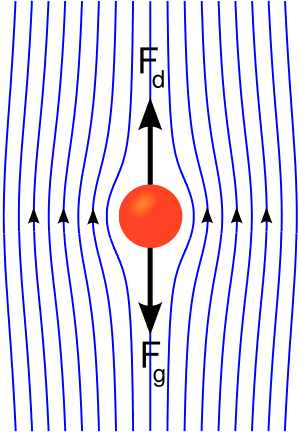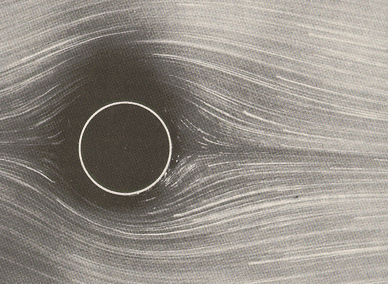We will assume that an object of mass ![]() is launched at an initial speed of
is launched at an initial speed of ![]() at an angle of
at an angle of ![]() above the horizontal. The acceleration due to gravity is
above the horizontal. The acceleration due to gravity is ![]() . We will assume that the ground underneath the projectile is essentially flat and perfectly level for the length that the projectile travels. We also will assume that the acceleration due to gravity is constant in the domain. In other words, we will ignore the curvature of the Earth.
. We will assume that the ground underneath the projectile is essentially flat and perfectly level for the length that the projectile travels. We also will assume that the acceleration due to gravity is constant in the domain. In other words, we will ignore the curvature of the Earth.
We define the following variables:
Newton's second law states that ![]() . Here the force due to gravity is
. Here the force due to gravity is ![]() .
Acceleration is the derivative of velocity over time and velocity is the derivative of position over time, so
.
Acceleration is the derivative of velocity over time and velocity is the derivative of position over time, so
Also, decomposing the initial velocity into vertical and horizontal components gives
Without air resistance, figuring out how far the projectile goes is easy. In this case the movement in the x-direction is effectively decoupled from the movement in the y-direction.
After launch, there is no horizontal acceleration, and the vertical acceleration is a a constant
How far does the projectile travel during this time? The object has an initial horizontal velocity of ![]() and travels at this speed for a time of
and travels at this speed for a time of ![]() , and so goes a total distance of
, and so goes a total distance of ![]()
An elastic collision is a term for describing the situation when two or more bodies come close to each other interact in a way that conserves both kinetic energy and momentum. Momentum is conserved in every reaction and so is energy, but in macroscopic scale reactions, kinetic energy can be lost to heat. This is used to great effect in car bumpers, whose sole design purpose is to crush, and thereby absorb some of the kinetic energy from a collision.
At the other end of the spectrum are objects like billiard balls which have nearly perfectly elastic collisions. If one billiard ball hits another straight on, then the first billiard ball will stop moving, and the second one will travel in the same direction at nearly the same speed as the first. In reality, though, some of the kinetic energy from the first ball is converted into a small amount of heat rather than going towards propelling the second ball.
The only truly elastic collisions are extremely small, like when molecules or smaller particles hit and bounce off of each other or when black holes gravitationally interact. Even when larger astronomical bodies interact with each other gravitationally, tidal forces conspire to convert some of the kinetic energy into heat.
Air resistance is oftentimes modeled using a square-law, meaning that the drag force due to air is proportional to the square of the speed of the object. For a particular object, the drag force will be ![]() , where
, where ![]() is some drag coefficient that depends on the particular shape and size of the projectile as well as on environmental factors such as air pressure. We will assume that
is some drag coefficient that depends on the particular shape and size of the projectile as well as on environmental factors such as air pressure. We will assume that ![]() is constant for the length of the flight.
is constant for the length of the flight.

 However, for projectiles with laminar flow and no turbulence, air resistance does not follow a square-law. In the derivation of the square-law, we assumed that the air particles bounce off of the projectile. When the flow is laminar (meaning smooth) as in the picture to the right, the air is only pushed around the projectile to make room for it, and then the air particles come back together largely unaffected after the projectile leaves. Here, because the air is only pushed outwards by a constant distance, irrespective of velocity, the amount of work done per unit time is proportional only to the amount of air pushed, which is proportional to the velocity of the object. So, the magnitude of the force from air resistance is proportional to speed. The direction of this force is directly opposing motion. We represent this by the equation
However, for projectiles with laminar flow and no turbulence, air resistance does not follow a square-law. In the derivation of the square-law, we assumed that the air particles bounce off of the projectile. When the flow is laminar (meaning smooth) as in the picture to the right, the air is only pushed around the projectile to make room for it, and then the air particles come back together largely unaffected after the projectile leaves. Here, because the air is only pushed outwards by a constant distance, irrespective of velocity, the amount of work done per unit time is proportional only to the amount of air pushed, which is proportional to the velocity of the object. So, the magnitude of the force from air resistance is proportional to speed. The direction of this force is directly opposing motion. We represent this by the equation ![]() , where
, where ![]() is some positive constant that depends only on the shape of the object and atmospheric conditions. This is the form of air drag that we will use in the following analysis.
is some positive constant that depends only on the shape of the object and atmospheric conditions. This is the form of air drag that we will use in the following analysis.
What makes this problem tractable is again the fact that we can solve for the vertical and horizontal movements independently of each other. However, it is not obvious why this should be so. After all, in this case, we have a force whose magnitude depends on the airspeed of the object, which in turn depends on both the horizontal and the vertical components of velocity. Additionally the direction of this new force (air resistance) is not in solely the vertical or horizontal directions. The direction of the new force is always against the direction of motion. Luckily, though, we can again show that the force of air drag in the horizontal direction depends only on the horizontal velocity and the force of air drag in the vertical direction depends only on the vertical velocity by the following equations:
![]()
![]()
Force is the product of acceleration and mass, and acceleration is the derivative of velocity over time :
This is a first-order linear differential equation and can be solved by the method of integrating factors to get the solution
where C is some real constant that depends on the initial velocity. Specifically, plugging in for time ![]() gives:
gives:
So the velocity, as a function of the initial conditions is :
Velocity is the derivative of position over time, so the position as a function of time is:
where C_0 is a constant that depends on the initial height of the projectile. We assume that the object is launched from the ground, so C_0 must be the constant that makes ![]() , and thus
, and thus